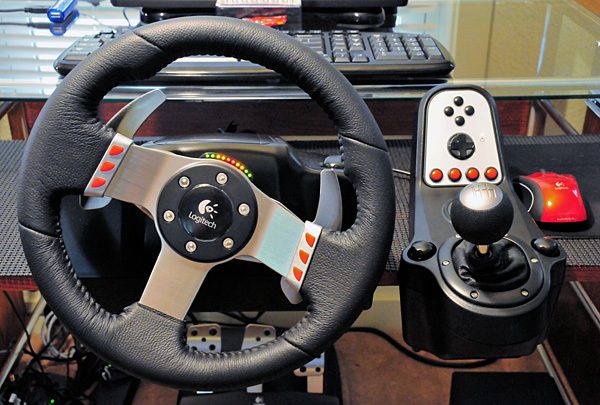
Introduction
 Darwin theorized that the process of evolution would cause a species to refine itself over time, with stronger, more effective traits advancing while weaker or ineffective traits were killed off. That theory also holds true in the computer gaming industry — so long as you accept that with every three advanced traits there is bound to be a misstep — or even a step backwards. Although the wheel’s existence was accidentally leaked on two earlier occasions, today Logitech officially unveiled their contribution to Darwin’s theory: the new G27 Racing Controller, an evolved version of the outstanding G25 released in 2006. Back then, the G25 was Logitech’s greatest gift to the racing simulation community, providing solid build quality, an array of new features and durable metal components wrapped in an appealing, steel-and-leather aesthetic that made it the class of the field.
Darwin theorized that the process of evolution would cause a species to refine itself over time, with stronger, more effective traits advancing while weaker or ineffective traits were killed off. That theory also holds true in the computer gaming industry — so long as you accept that with every three advanced traits there is bound to be a misstep — or even a step backwards. Although the wheel’s existence was accidentally leaked on two earlier occasions, today Logitech officially unveiled their contribution to Darwin’s theory: the new G27 Racing Controller, an evolved version of the outstanding G25 released in 2006. Back then, the G25 was Logitech’s greatest gift to the racing simulation community, providing solid build quality, an array of new features and durable metal components wrapped in an appealing, steel-and-leather aesthetic that made it the class of the field.As good as it was, the G25 wasn’t perfect. Reviewers and consumers noted several areas that were ripe for improvement. And Logitech’s engineers listened. In time, plans were set in motion to produce a refined version of the G25, one that addressed the critical comments of the sim racing community. The G27 is replacing the G25 in Logitech’s racing controller lineup; with the G27 hitting store shelves in late September (Europe will follow, likely in October). Recently SimHQ got its hands on a G27, and we’ve given it a thorough test-drive, allowing us to share our assessment of this new product with you.
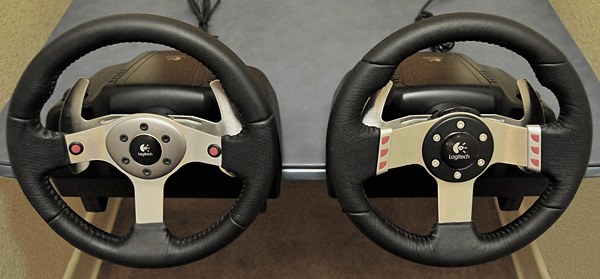
The Logitech G25 and G27 Racing Controllers
Since the G27 refines and builds on the solid features of the G25, our review will focus on the differences between the two products — differences that both enhance, and potentially detract, from your sim racing experience. If you’re not familiar with the G25, please check out SimHQ’s in-depth, review series here. Now, let’s tear into Logitech’s newest offering with a look at the G27’s new features.
More Buttons On The Wheel
A common critique of the G25 was that despite offering a total of 10 programmable buttons and an 8-way D-pad, only two of those buttons were placed on the wheel itself. The other buttons afforded great programmability, but required you to take your attention off the road and a hand off the wheel in order to actuate them. Now, the G27 boasts four additional buttons on the leather-wrapped, 11” wheel. This necessitated wider metal spokes on the wheel itself, but the increased spoke size was minimized by using smaller buttons.

G27 Wheel Hub Lights and Buttons
Wheel-Mounted LED rpm / shift Lights
Atop the wheel hub is a streamlined plastic fairing containing a 10 LED array, with 5 pairs of lights that illuminate in an advancing string from green to amber to red, indicating relative rpm and arrival at the desired shift point on the power curve. The LED array emulates the way modern Formula 1 cars display relative rpm and shift points to their drivers, and is a glitzy addition to the G27. In order for them to work, the racing sim in use has to support their operation. Logitech created a software developer kit (SDK) for simulation development teams, and titles are now appearing that support this G27 feature. The G27 comes bundled with a version of rFactor that supports LED operation, SimBin has already included support for the rpm/shift LED in the Steam versions of Race ‘07 and GTR Evo, and other upcoming racing titles should also support it. The rpm/shift LED may be of particular value to people who prefer to drive in other than the cockpit view.
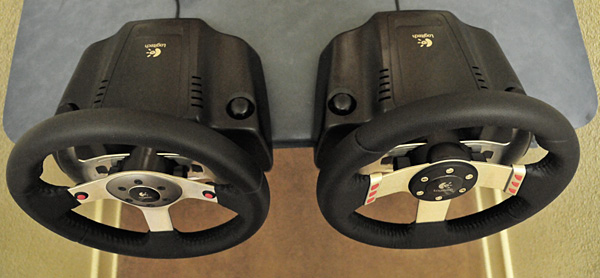
The G25 and G27 Uses the Same Housing
Helical Force Feedback Gearing
OK, so you’re probably wondering what the heck a helical gear is. Helical gears have the spine of each gear tooth cut at an angle that is not perpendicular to the gear disk. Make sense? No? Well, a picture says a thousand words, so check out these two videos:
The G25’s dual motor force feedback system used conventional straight-cut or “spur” gears on the FFB transmission. They’re simple to manufacture, but as we now know they can be loud and generate vibration when the gears are rotated quickly, due to the rate at which the teeth make contact with each other.Now take a look at a set of helical gears. The angled gear teeth allow for a more gradual rate of contact between the teeth, resulting in smoother, quieter force feedback with less vibration. But switching to helical gears required Logitech to up the ante with much tighter manufacturing tolerances. Helical gearing, combined with a transmission supported by two sets of steel ball bearings, helps the G27 advance the breed in terms of wheel smoothness and efficiency.
New Paddle Shifter Switch Geometry
The G27 features enlarged paddle shifter micro-switch housings that are now external to the wheel shaft cover. The micro-switch pins visibly stick out of each housing, which hopefully won’t make them vulnerable to dust intrusion or damage.

G25 Paddle Switches
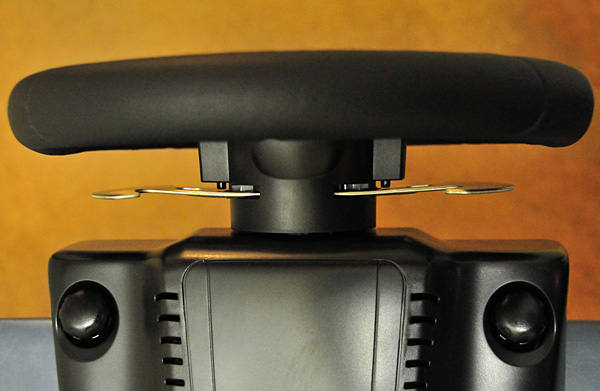
G27 Paddle Switches
Pedal Geometry Changes
Although SimHQ raved about the G25’s pedals in its 2006 review, the one area for improvement revolved around the geometry of the pedal faces. With all three in the same plane, it was very difficult to effectively execute heel-and-toe shifting. What was needed was to set the throttle pedal back a bit, so that a driver’s foot didn’t touch it until the brake was slightly depressed. Again, Logitech’s engineers were listening, and on the G27 the brake and clutch pedals moved forward with the help of a 13mm spacer block behind the pedal face, allowing for more natural and effective heel-and-toe braking.
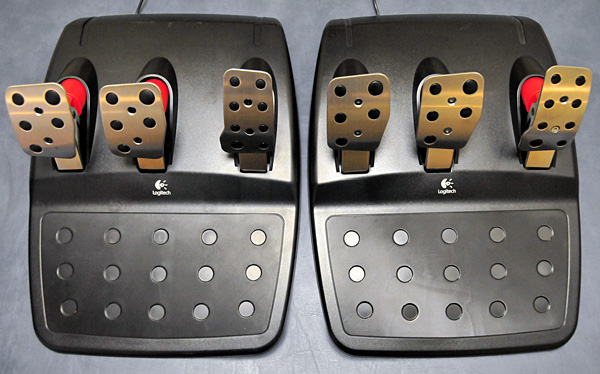
G27 (left) and G25 Pedals
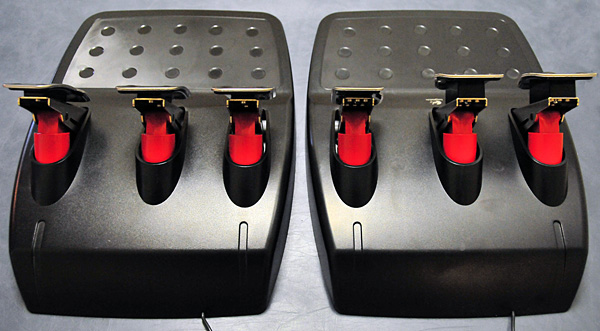
G25 (left) and G27 Pedals
Adjustable Pedal Face Locations
By including two additional sets of bolt holes in each pedal actuator, consumers can now tailor their G27’s pedal face locations to further refine heel-and-toe ergonomics. Each G27 comes with pedal faces attached to the center attach holes, but with the use of an Allen wrench from your tool box, drivers can alter the location of each pedal face about ¼” left or right. This is a very welcome feature as feet come in all shapes and sizes.
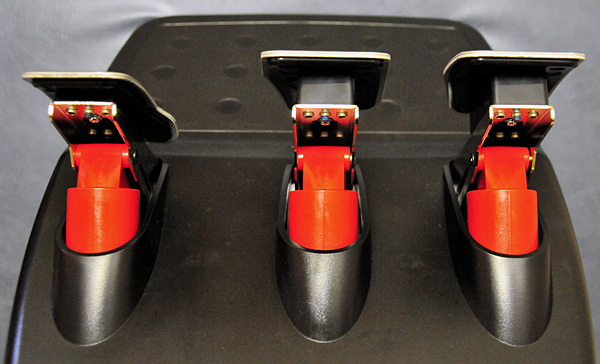
G27 Pedal Spacer Blocks
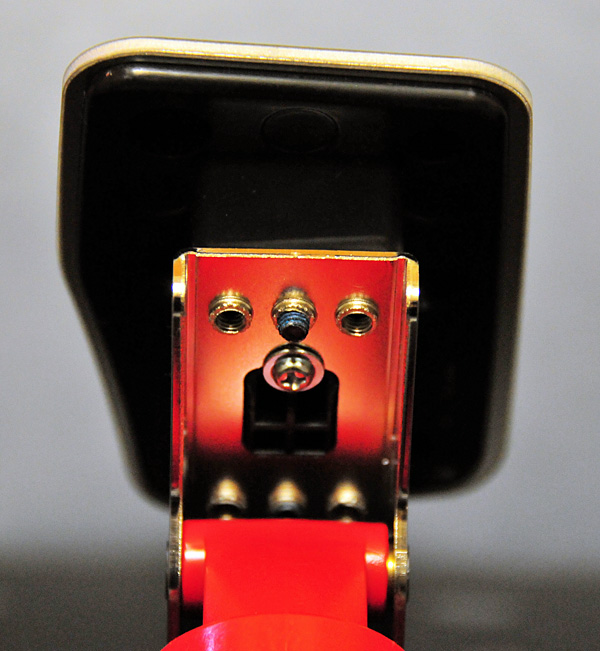
G27 Pedal Adjustment Holes
Improved Shifter Feel
The dual mode H-pattern/Sequential shifter pod was a versatile and ambitious feature of the G25, but ultimately the very things that made the shifter unit the product’s most appealing aspect eventually became the G25’s Achilles heal. Some necessary design compromises left the shifter’s H-pattern mode with a weak and vague feel that accurately simulated a shifter made from wet pasta and seemed prone to mechanical breakdown, despite having moving parts constructed of steel. The G27 addresses those issues with a complete redesign of the shifter unit aimed at giving a quieter, more positive ‘feel’ to the H-pattern shifter. It also eliminates the light clicking noise that really made the G25 shifter sound like a cheap toy.
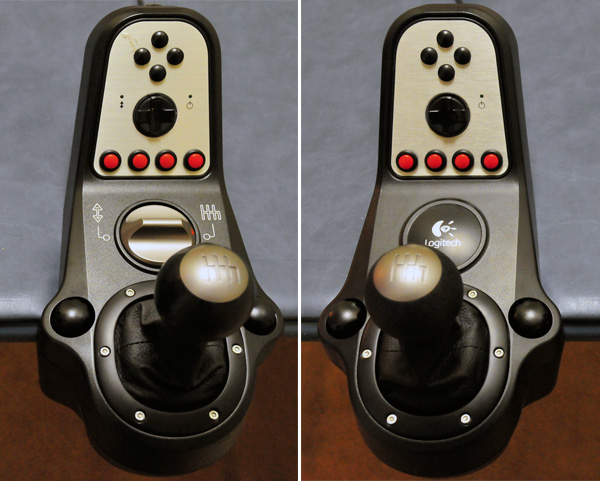
The G25 and G27 Shifters
Shifter Specialization
Just as the G25 shifter design required compromises, so too does the G27’s. Increasing the firmness and positive action of the H-pattern shifter not only meant tightening up some spring tensions, but also clearing out some conflicting hardware. After a lot of hand-wringing and arguing, the Logitech team decided that in order for the H-pattern to fulfill its destiny the sequential shifter had to go. Yes, you read that right: the G27 has no option for emulating a modern race car’s sequential transmission, other than the wheel’s paddle shifters.
New Software
The G27 ships with Logitech Profiler version 5.05 and an rFactor DVD with the LED support. Like the rest of Logitech’s racing wheel lineup, the G27 is compatible with PC, PS3 and PS2 gaming platforms. Thankfully, the new Profiler’s wheel calibration/test GUI no longer has loud explosion sound effects tied to each wheel button activation, remaining peacefully mute during FFB checks.
Driver’s Assessment
To establish the veracity of the G27’s pedigree, I tried the wheel out with a variety of racing titles: rFactor (using 1970 World Sports Car Championship 1.0, ILMS 2.77P, and PCC 2007 mods), Race ‘07 (WTCC ’07 and Radical SR3) and Richard Burns Rally. I tried the G27 with GT5 Prologue on the PS3.
Before getting started, I had to adjust rFactor and Race ’07 so that the car’s gearing goes into neutral in between shifts. To do that, I had to to edit a line in the controller profile. For Race ’07, go to the My Documents\SimBin\Race 07\UserData\ControlSet folder, find the .rcs file for the controller profile you made and alter this line: “Gear Select Hold Button =”, changing the value from “0” to “1”. The process for rFactor is similar.
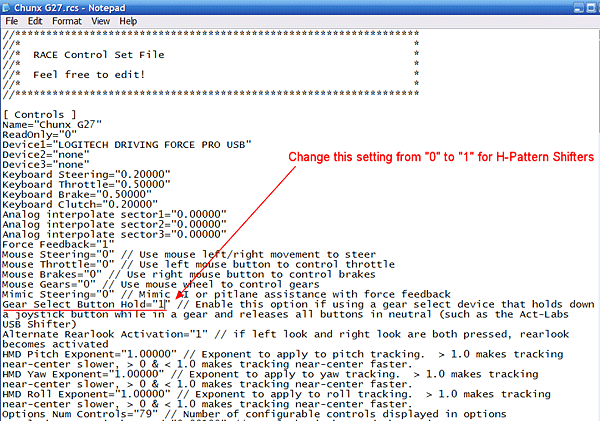
From the moment you crank up a racing sim and start driving with the G27, its build quality and operational refinement become stunningly apparent. The G27 feels and performs exactly as advertised — like an improved version of the already impressive G25. Wheel rotation is silky smooth, almost like a real car, with little shaft noise. Car control when cornering is very precise. The LED rpm/shift light array matched up perfectly with Race ‘07’s HUD tachometer, and looked really cool. The shifter, while still light to the touch, is firm and positive. The shifter’s stronger centering spring and tighter movement makes for fewer missed shifts. And the pedals — ah, the pedals — are very well adjusted from an ergonomic perspective. Quite simply the pedals rock, and I found that repositioning the pedal faces was not only easy, but also helped tailor the pedals to better accommodate my heel-and-toe technique.
Overall, the G27 is a precise, classy and polished piece of equipment. But that doesn’t mean sim racers won’t find their own nits to pick.
Here are mine:
Tighter tolerances in the G27’s helical force feedback gears seem to have forced Logitech to program in a slightly larger "soft spot" in turning resistance near top center. G25 owners know that when their wheel is a few degrees either side of centered, the force feedback and turning forces drop off slightly. This is to prevent the force feedback engine from producing divergent oscillations. While real cars also have a slight drop in turning resistance near center due to tire geometry, the G27’s soft spot is wider and has a noticeably steeper ramp-up in forces at its edges. When driving in Race ’07 I could feel a tiny bit of FFB-induced oscillation (wobble) while driving on long straights, and in GT5 Prologue straight line steering was just a bit vague with the wheel centered (although that might be an issue with the PS3).More buttons on the wheel are a welcome addition, but they all have an identical tactile feel, which forces you to look at them — and away from the road — to confirm you’ve put the right one under your thumb. That partially defeats the purpose of putting buttons on the wheel in the first place. The lower buttons can be an awkward reach if you have large hands. The metal paddle switch levers are superb and the new micro-switch geometry makes for very positive operation, including a louder engagement "click". The G27’s paddles really put me “in the cockpit” of my Porsche Spyder RS from rFactor’s ILMS 2.77 mod.The LED array worked well with Race ‘07, but only when running Steam’s on-line version of the game. The LED rpm/shift lights look really trick and match up perfectly with the in-game rpm displays. But if your sim racing rig is a computer desk, you’ll have to glance down from the monitor to see them. Because the LEDs are so far below the line-of-sight to my monitor, they’re more gimmick than useful feature with my gaming configuration. Mounting the G27 in an F1-style cockpit that puts the LED array in the same line-of-sight as the monitor would probably make them more useful.The shifter action is very positive, but as you’d expect from a desktop shifter lacking mass and heft, it still has a bit of a light touch. Combine that with a fairly long-ish throw between gears and missed shifts are only slightly reduced. The lack of a sequential shifter mode was a bit of an immersion-killer for some of the cars and sim titles, as the H-pattern’s motions felt all wrong for the type of vehicle being replicated.In rally games such as Richard Burns Rally and DiRT, the rearward position on a sequential shifter can be reassigned and makes for a nice, improvised hand-brake. With no sequential shift option on the G27 I was concerned that there would be no intuitive way to emulate this important control. In RBR I assigned the G27’s 4th gear position to be the hand brake, and although I found it more awkward and less intuitive to operate than a sequential shifter, it did get the job done. Sometimes after actuating the hand brake I would fail to get the shifter all the way back into neutral, thereby sliding my car to a halt — something that can’t happen when a spring-centered sequential shifter is used as the hand-brake.While some will rejoice in the refined H-pattern shifter, others will find the removal of the sequential shifter to be the proverbial turd in the G27’s punchbowl. Like many sim racers, I particularly enjoy racing simulations that emulate modern GT, endurance and touring cars. These types of cars utilize a floor-mounted, two-position sequential shifter for up- and down-shifts. The G25 shifter’s sequential mode was ideal for emulating this type of racing transmission. Since the core of any sim racing experience is to attempt to match the basic physical mechanics of car operation, Logitech has inadvertently blown a hole in their premier racing wheel’s ability to simulate a wide range of modern race cars. And abandon all hope, ye who upgrade to G27: The G25’s shifter isn’t compatible with the G27’s firmware. Yes, I already asked.Many consumers were hoping that Logitech would endow the G27 with cross compatibility for the Xbox 360, PS3 and PC. However, that wasn’t to be. While that one element doesn’t take away from Logitech’s other achievements with the G27, it does leave us wanting more in terms of product versatility.
Features and fixes Logitech should build Into the next G2x
ConclusionGive the wheel-mounted buttons a unique tactile feel. Provide shape or texture variation in the button faces, such as Braille-style pips, to give each a unique tactile feel. Also, keep their location far enough from the wheel rim to ensure ergonomic operation. Future products could include one or two rotating switches, like F1 cars have.Improve force feedback wheel’s on-center feel and response. Smoother, quieter steering action is nice, but not at the expense of a huge null at wheel center that compromises straight line tracking and increases workload.A more capable LED/LCD driver display that is detachable. Ultimately a small, monochrome LCD, MOTEC-style display that interfaced with the game would really rock. Something only 3x bigger than a wristwatch would probably be enough, and could show things like relative rpm, speed, gear and laps remaining.Pedal Refinement. The pedals are damn good in their current form. Perhaps the next product will be the right time to introduce an inverse-resistance clutch pedal, force feedback in the brake pedals to replicate wheel lockup or ABS, or a brake with a load-sensor instead of a potentiometer.Include a Sequential Shifter. One way or another, the sequential shifter needs to make a return in the next Logitech product.Provide a hand brake lever. To better support rally, drifting and off-road simulations, a small hand-brake lever is required.Develop a force feedback racing wheel that is cross-compatible with the PC, PS3 and the Xbox 360. As more and more racing sim titles are released for the Xbox 360 and PS3, the demand for a single, quality racing wheel that can swap between PC and Xbox will continue to increase.Logitech Profiler for Dummies. Offer tailored, game-specific settings options and suggestions as well as enhanced tool tips or tutorials on what each slider function does and how games will react to various settings. Work with simulation developers and leading sim racers to include their recommended game-specific settings to maximize the experience without excessive research or trial-and-error by newbies.
Despite years of media pundits predicting the simulation genre’s demise, Logitech continues its superb support of our small, demanding (and sometimes irritating) community with yet another high-quality, well crafted and feature-packed racing controller that improves the breed.
Although this latest effort is merely an evolved version of the already superb G25 wheel, the G27 reiterates Logitech’s commitment and desire to satisfy the sim racer’s needs. Overall, the G27 retains all the goodness of the G25, and piles on a wide array of highly desirable new features and refinements. The pedals are fantastic. The wheel is quite the work of art, both inside and out. The G27 is yet another product the Logitech team can take pride in, and something the simulation community will appreciate. But for all the improvements, the G27’s feature set fails to make one critical step forward, and takes one big, unfortunate step backward.
With the appearance of simulation-level racing titles on the Xbox 360 such as Race Pro and Forza Motorsports 3, Logitech’s failure to produce a wheel cross-compatible with the dominant gaming console hinders the growth of the sim racing genre at a critical juncture. For fans of modern GT or touring car racing, the decision to omit the sequential shifter will be a big disappointment. That omission may be enough to keep some consumers from parting with their G25 — or drive them to rival products that still offer the option. We can only hope that Logitech’s engineers are reading this review, and get the message: We need a quality, multi-platform racing wheel, and we need our sequential shifter back! (…and a handbrake would be nice, too).

Reviewer System Specs
System 1
- Dell XPS M1710 Red gaming laptop.
- CPU: Core2 Duo T7200 (2.00GHz, 4MB L2 Cache, 667 MHz FSB)
- RAM: 2GB DDR2 SDRAM at 667MHZ
- GPU: NVIDIA GeForce Go 7950 GTX 512 MB
- AUDIO: Sigmatel Integrated + Sound Blaster Audigy HD Software Edition
- HDD: 80GB 7200 rpm SATA
- OS: Windows XP Media Center 2005, SP2
- Screen: 17” UltraSharp Wide Screen UXGA (1920x1200 native resolution)
- Optical Drive: 8X CD/DVD Burner (DVD+/-RW) with double-layer DVD+R write
System 2
- Sony Playstation 3
- 52" Plasma Monitor
